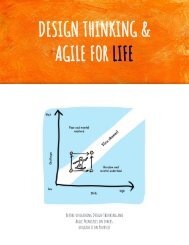2020 iLEAD e-book
- No tags were found...
Create successful ePaper yourself
Turn your PDF publications into a flip-book with our unique Google optimized e-Paper software.
S3 -‐ Participating / Supporting<br />
Low task focus, high relationship focus -‐ leaders pass day -‐to-‐day decisions, such as task allocation and<br />
processes, to the follower. The leader facilitates and takes part in decisions, but control is with the follower.<br />
For people who have competence, but lack confidence or motivation. They do not need much direction<br />
because of their skills, but support is necessary to bolster their confidence and motivation<br />
S4 -‐ Delegating<br />
Low task focus, low relationship focus -‐ leaders are still involved in decisions and problem-‐solving, but control<br />
is with the follower. The follower decides when and how the leader will be involved. For people who have<br />
both competence and commitment. They are able and willing to work on a project by themselves with little<br />
supervision or support.<br />
Effective leaders are versatile in being able to move around the matrix according to the situation, so there is<br />
no style that is always right. However, we tend to have a preferred style, and in applying SL you need to know<br />
which one that is for you.<br />
Likewise, the competence and commitment of the follower can also be distinguished in 4 quadrants.<br />
DEVELOPMENT LEVEL OF THE FOLLOWER<br />
D4 -‐ High Competence, High Commitment<br />
Experienced at the job, and comfortable with their own ability to do it well. May even be more skilled than the<br />
leader<br />
D3 -‐ High Competence, Variable Commitment<br />
Experienced and capable, but may lack the confidence to go it alone, or the motivation to do it well / quickly<br />
D2 -‐ Some Competence, Low Commitment<br />
May have some relevant skills, but won't be able to do the job without help. The task or the situation may be<br />
new to them<br />
D1 -‐ Low Competence, High Commitment<br />
Generally lacking the specific skills required for the job in hand, but has the confidence and / or motivation to<br />
tackle it. Similar to the leadership styles, the development levels are also situational. A person could be skilled,<br />
confident and motivated for one part of his his job, but could be less competent for another part of the job.<br />
Blanchard and Hersey said that the Leadership Style (S1 -‐ S4) of the leader must correspond to the<br />
Development level (D1 -‐ D4) of the follower -‐ and it's the leader who adapts. By adopting the right style to suit<br />
the follower's development level, work gets done, relationships are built up, and most importantly, the<br />
follower's development level will rise to D4, to everyone's benefit.<br />
STEPS IN SL PROCESS<br />
1. Make an overview per employee of his/her tasks<br />
2. Assess the employee on each task (D1...D4)<br />
3. Decide on the leadership (management) style per task (S1...S4)<br />
4. Discuss the situation with the employee<br />
5. Make a joint plan<br />
6. Follow-‐up, check and correct

















